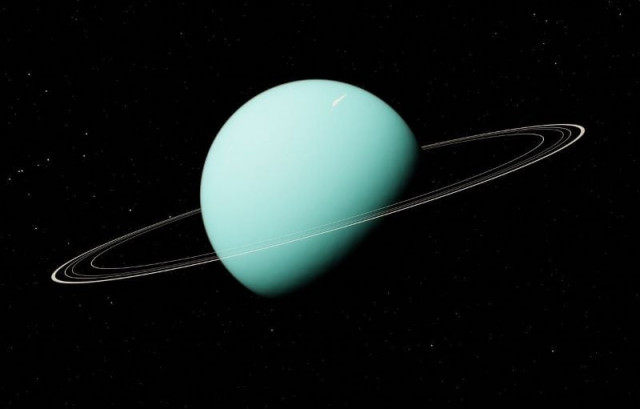Uranus: 243 years later, new discoveries challenge what we thought we knew
Uranus, blue-green in color due to the methane contained in an atmosphere comprised mostly of hydrogen and helium

In 1781, German-born British astronomer William Herschel made Uranus the first planet discovered with the aid of a telescope. This frigid planet, our solar system's third largest, remains a bit of an enigma 243 years later. And some of what we thought we knew about it turns out to be off the mark.
Much of the knowledge about Uranus was gleaned when NASA's robotic spacecraft Voyager 2 conducted a five-day flyby in 1986. But scientists have now discovered that the probe visited at a time of unusual conditions - an intense solar wind event - that led to misleading observations about Uranus, and specifically its magnetic field.
The solar wind is a high-speed flow of charged particles emanating from the sun. The researchers took a fresh look at eight months of data from around the time of Voyager 2's visit and found that it encountered Uranus just a few days after the solar wind had squashed its magnetosphere - the planet's protective magnetic bubble - to about 20% of its usual volume.
"We found that the solar wind conditions present during the flyby only occur 4% of the time. The flyby occurred during the maximum peak solar wind intensity in that entire eight-month period," said space plasma physicist Jamie Jasinski of NASA's Jet Propulsion Laboratory, lead author of the study published on Monday in the journal Nature Astronomy.
"We would have observed a much bigger magnetosphere if Voyager 2 had arrived a week earlier," Jasinski said.
Such a visit likely would have shown that the Uranus magnetosphere is similar to those of Jupiter, Saturn and Neptune, the solar system's other giant planets, the researchers said. A magnetosphere is a region of space surrounding a planet where the planet's magnetic field dominates, creating a protective zone against solar and cosmic particle radiation.
The Voyager 2 observations left a misimpression about the magnetosphere of Uranus as lacking in plasma and possessing uncommonly intense belts of highly energetic electrons.
Plasma - the fourth state of matter after solids, liquids and gases - is a gas whose atoms have been split into high-energy subatomic particles. Plasma is a common feature in the magnetosphere of other planets so its low concentration observed around Uranus was puzzling.
"The plasma environment of any planetary magnetosphere is usually formed of plasma from the solar wind, plasma from any moons present inside the magnetosphere and plasma from the atmosphere of the planet," Jasinski said.
"At Uranus, we did not see plasma from the solar wind or from the moons. And the plasma that was measured was very tenuous," Jasinski said.
Uranus, blue-green in color due to the methane contained in an atmosphere comprised mostly of hydrogen and helium, has a diameter of about 31,500 miles (50,700 km). It is big enough to fit 63 Earths inside it. Among the solar system's eight planets, only Jupiter and Saturn are larger.
Its unusual tilt makes Uranus appear to orbit the sun like a rolling ball. Uranus, which orbits almost 20 times further from the sun than Earth does, has 28 known moons and two sets of rings.
The Voyager 2 observations had suggested that its two largest moons - Titania and Oberon - often orbit outside the magnetosphere. The new study indicates they tend to stay inside the protective bubble, making it easier for scientists to magnetically detect potential subsurface oceans.
"Both are thought to be prime candidates for hosting liquid water oceans in the Uranian system due to their large size relative to the other major moons," Jet Propulsion Laboratory planetary scientist and study co-author Corey Cochrane said.
Scientists are eager to learn whether subsurface oceans on moons in the outer solar system have conditions suitable to support life. NASA on Oct. 14 launched a spacecraft on a mission to Jupiter's moon Europa to address that very question.
"A future mission to Uranus is crucial to understanding not only the planet and magnetosphere, but also its atmosphere, rings and moons," Jasinski said.



















COMMENTS
Comments are moderated and generally will be posted if they are on-topic and not abusive.
For more information, please see our Comments FAQ